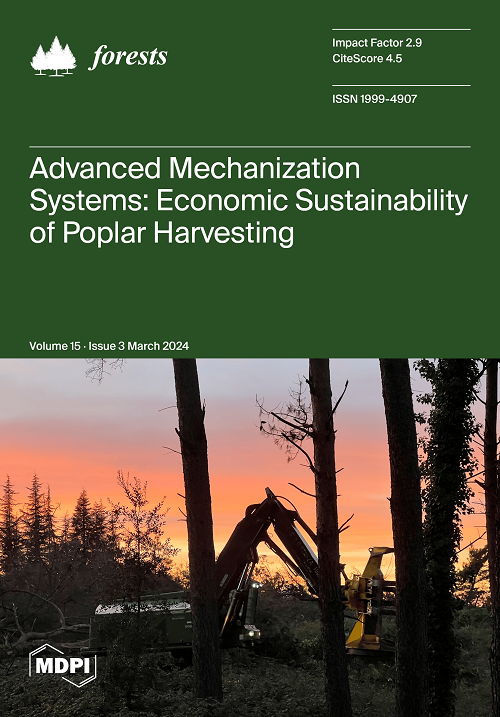沙漠地区两种盐碱生境中叶和根的生理生化特征的变化
IF 2.5
2区 农林科学
Q1 FORESTRY
引用次数: 0
摘要
盐胁迫是对植物生长和发育产生不利影响的一个关键环境因素。高盐度会诱发一系列形态和解剖特征上的结构和功能变化。在自然环境中,K. foliatum 对盐胁迫的生理生化变化尚不清楚。基于此,本研究选取 K. foliatum 作为研究对象,比较分析了高盐生境和低盐生境下叶片和根组织生理生化指标的差异。结果表明,在高盐环境下,K. foliatum叶片中的叶绿素含量下降,而上下表皮的厚度和栅栏组织的厚度显著增加。高盐环境导致 K. foliatum 的叶片和根部组织中的氮和磷含量下降,导致元素的化学计量比发生变化。K. foliatum 根部的 C、N 和 P 含量低于叶片。K. foliatum 根中 Na+ 的积累量大于叶片,根能促进钠离子向叶片的运输。叶片中的淀粉和可溶性糖含量在高盐生境中的比例高于低盐生境,而根和叶片的变化则相反。随着盐分含量的增加,叶片和根中的脯氨酸含量显著增加,根中的脯氨酸含量低于叶片。与低盐度生境相比,高盐度生境的叶片和根中过氧化物酶和超氧化物酶的含量更高。叶片的超氧化物歧化酶(SOD)活性和根部的过氧化氢酶(CAT)活性是高盐生境中的 "核心特征"。在低盐生境中,叶片丙二醛(MDA)和根的 C/N 是叶片和根的中心性状,这表明 K. foliatum 以不同的方式适应盐环境的变化。本文章由计算机程序翻译,如有差异,请以英文原文为准。
Variations in Physiological and Biochemical Characteristics of Kalidium foliatum Leaves and Roots in Two Saline Habitats in Desert Region
Salt stress is a key environmental factor that has adverse effects on plant growth and development. High salinity induces a series of structural and functional changes in the morphological and anatomical features. The physiological and biochemical changes in K. foliatum in response to salt stress in natural environments are still unclear. Based on this, this study compared and analyzed the differences in the physiological and biochemical indicators between the leaf and root tissues in high-salt and low-salt habitats, selecting K. foliatum as the research object. The results showed that the chlorophyll contents in the leaves of K. foliatum decreased in the high-salt habitat, while the thicknesses of the upper and lower epidermises, as well as the thicknesses of the palisade tissue, significantly increased. The high-salt environment led to decreases in the N and P contents in the leaves and root tissues of K. foliatum, resulting in changes in the stoichiometric ratio of elements. The concentrations of C, N, and P in the roots of K. foliatum were lower than those in the leaves. The accumulation of Na+ in the K. foliatum roots was greater than that in the leaves, and the roots could promote the transport of sodium ions to the leaves. The contents of starch and soluble sugar in the leaves showed higher proportions in the high-salt habitat than in the low-salt habitat, while the changes in the roots and leaves were the opposite. As the salt content increased, the proline contents in the leaves and roots of K. foliatum significantly increased, and the proline contents in the roots of K. foliatum were lower than those in the leaves. The leaves and roots exhibited higher levels of peroxidase and superoxide enzymes in the high-salinity habitat than in the low-salinity habitat. The superoxide dismutase (SOD) activity of the K. foliatum leaves and catalase (CAT) activity of the roots were the “central traits” in the high-salt habitat. In the low-salt habitat, the leaf malondialdehyde (MDA) and root C/N were the central traits of the leaves and roots, indicating that K. foliatum adapts to changes in salt environments in different ways.
求助全文
通过发布文献求助,成功后即可免费获取论文全文。
去求助
来源期刊

Forests
FORESTRY-
CiteScore
4.40
自引率
17.20%
发文量
1823
审稿时长
19.02 days
期刊介绍:
Forests (ISSN 1999-4907) is an international and cross-disciplinary scholarly journal of forestry and forest ecology. It publishes research papers, short communications and review papers. There is no restriction on the length of the papers. Our aim is to encourage scientists to publish their experimental and theoretical research in as much detail as possible. Full experimental and/or methodical details must be provided for research articles.
 求助内容:
求助内容: 应助结果提醒方式:
应助结果提醒方式:


